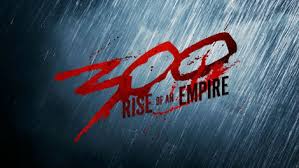
So
300 is getting a sequel called
300: Rise of an Empire.
That’s weird to me on a few different levels,
but I’m also surprisingly excited to
see it.
I wasn’t a huge fan of the
original movie, but I appreciate it as a modern progression of the
swords-and-sandals epics of old.
Some of you may be asking what this movie will actually be about.
300 ends with a fairly concise
conclusion, because they all died.
Where can the movie go from there?
Judging
from the
trailers, the vast majority of the movie will be centered on a naval
conflict between the Athenians and the Persians.
The main hero is an Athenian commander played
by relative unknown Sullivan Stapleton and his main opponent seems to be Eva
Green as one of the main villains for the piece.
What does any of this mean?
Let’s get started with who our main
characters are and go from there.


According to
casting information, Green will be playing Artemisia I, who was the queen of the
Satrap of Caria.
Satraps were more or
less the provinces of the First Persian Empire.
It’s worth remembering from history class that one
of the things that made the Persian Empire so effective was that when they
conquered a region, they would generally leave the local hierarchies intact.
The region was still under Persian rule and
benefited from the resources of the Empire like a massive network of paved roads, but apart from paying taxes and contributing troops to war efforts, kingdoms
were more or less autonomous.
After all, who knows how to run a region better than the people who were already running
it?
In short, Xerxes really wasn’t
kidding when he told Leonidas he would make him a king in the last movie. That was his best administrative tactic.

Anyway, Artemisia
was the effective queen of Caria, a region in western Anatolia (modern day
Turkey).
In his histories of the region, Herodotus
noted the amount of influence she had on King Xerxes, providing him with counsel
and insight during his reign.
So yeah,
there’s your femme fatale for the movie.
Artemisia ascended to the throne following the death of her husband and
despite being of Grecian descent herself (her mother was from the Greek isle of Crete), she allied herself with Xerxes during the Second Greco-Persian
War.
Her most well-known contribution to
the war effort was serving as one of two Persian commanders at the Battle of Artemisium,
opposite the Athenian general Themistocles.

Themistocles
was an Athenian politician of whom we know very little prior to his rise to
prominence.
We have only vague
descriptions of his father as a “not very conspicuous man,” and we know even
less of his mother.
He
grew up during a mercurial period of transition for Athens.
The failings of the current ruling class and
a costly war with Sparta had decimated the Athenian government system and the
city’s people had decided to implement a new form of government known as democracy.
Having risen from the gentry, Themistocles
proved himself a natural born politician who danced rhetorical circles around
his old guard opponents.
Luckily he was
also a populist, and used his power to give the common man a voice.
Using these talents, Themistocles was able to
ride a steady wave of successes until he was promoted to archon (full title
Eponymous Archon) or effective ruler of Athens.
He also fought in the first "phase" of the Second Greco-Persian War, possibly even as a
general at the decisive Battle of Marathon.

In 481 BC,
the Greeks learned that the Persian Empire had once again turned its eye their
way.
Roughly 30 city-states allied
themselves to organize a defense against any Persian incursions.
The two city-states to lead this alliance were
Athens and Sparta, both of whom were sworn enemies of Persia.
The Spartans almost immediately laid their
claim to command of the land battle, and nobody was really keen to stop them
since it was effectively impossible for the other city-states to beat Sparta on
land.
Once this was decided, 10,000
hoplites under the joint command of the Spartan polemarch Euenetus and
Themistocles marched to the Vale of Tempe to await the Persians.
However, in a surprising turn of events,
Alexander I of Macedon informed the allied states that it was possible (and
indeed more tactically sound) to enter Greece through other, more discrete
routes.
Soon after, the alliance received
even more dire news: Xerxes and his forces had crossed the Hellespont, a strait
that connects Turkey to Greece.

As the
combined forced raced back to the city-states to defend their land, it was
clear the Alliance was on the verge of breaking.
It was here Themistocles took center
stage.
Themistocles had developed a
second strategy to defend the peninsula.
He pointed out that Xerxes’ land force needed to pass through the narrow
pass at Thermopylae and argued that a small force of hoplites could defend the
pass while the massive Athenian navy, which Themistocles had assembled for just
such an occasion, could meet the Persian navy off the coast.
While the Spartan king Leonidas took a force
of Spartan hoplites, Helots, and a number of other support forces from across
the Alliance to the pass, Themistocles and two other Athenian generals took to
the seas to meet the Persians.
This
resulted in two naval engagements: the Battle of Artemisium, which was a loss
for the Greeks after three days of brutal fighting, and the Battle of Salamis,
which turned the tide of the war.
So
that’s probably what
Rise of an Empire
will be about.
On one hand,
I’d wager the film will feature the Battle at Salamis exclusively because the
narration in one of the trailers indicates that the events of the story are
taking place after the Battle of Thermopylae much like Salamis did (Artemisum
was concurrent with the Battle at Thermopylae).
On the other hand, what makes Salamis interesting as a battle hinges on
the eventual defeat at Artemsium. Either
way, this is why I’m excited for 300:
Rise of an Empire. Part of what made
the original 300 such a slog for me
was that you could tell just how artificial the fights were. Ground wars
in ancient Greece usually weren’t that…dynamic.
In contrast, ancient naval engagements were brutal, drawn-out and very
violent.

The weapon
of choice for any ancient navy was the trireme, a long ship with a pair of
triangular sails supported by three decks of men rowing with long handled oars.
Triremes were fast and maneuverable by the
standards of the time but they lacked a key element that is necessary for naval
combat, namely on-board ranged weaponry.
As such, the primary tactic of the time was to ram and board the enemy
vessel, which triremes were very good at.
The prow of a trireme was designed to be a massive battering ram, and if
anything else had been sacrificed to make the ship faster, then it would have
compromised the ship’s integrity.
Furthermore,
each trireme was staffed by a contingent of marines who would jump between
vessels and engage the crews of other ships as soon as their ship plowed into
another, assuming the other one hadn’t been smashed into splinters already.
So apart from the visual saturation and
Snyder’s signature hyper-violence, you can bet what you see in
300: Rise of an Empire is more or less
what actual naval warfare was like in 482 BC.
And it should be awesome. Despite all my hesitancy about the movie, that's what will make it all worth it, at least to me.
Sources:
http://en.wikipedia.org/wiki/Artemisia_I
http://en.wikipedia.org/wiki/Themistocles
No comments:
Post a Comment